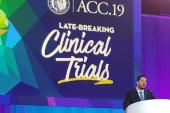ACC Issues New Guidance Around Antithrombotic Choices in A-fib, VTE
The recommendations aim to help clinicians navigate tricky scenarios when both anticoagulants and antiplatelets are needed.

Clinicians have a new tool to help them in deciding how best to balance risks and benefits when there’s a need to mix anticoagulation and antiplatelet therapy in patients with A-fib or venous thromboembolism (VTE). It comes in the form of an expert consensus decision pathway from the American College of Cardiology (ACC).
“In general, we have recommended against routine use of triple therapy, which would be [dual antiplatelet therapy (DAPT)] plus anticoagulation,” Dharam Kumbhani, MD (UT Southwestern Medical Center, Dallas, TX), chair of the writing committee, told TCTMD.
Double therapy is the way to go for most cases “based on the concordance of all the data that’s available,” he said, “and several meta-analyses that have looked at that and provided that conclusion.” There are some scenarios—when a patient has a high thrombotic risk and low bleeding risk, for example—for which physicians may opt for triple therapy for a short duration, Kumbhani noted. “We’ve left that distinction to providers. We haven’t tried to be overly prescriptive and try to define what high-risk means.”
These types of decisions are common in practice as patients with A-fib or VTE—often treated with anticoagulation—frequently have coronary disease that requires antiplatelet therapy. It can be challenging to maintain the antithrombotic effects of treatment while minimizing bleeding risks.
The decision pathway, published online December 18, 2020, ahead of print in the Journal of the American College of Cardiology, is meant to help clinicians navigate these situations. It incorporates discussions from two Heart House Roundtables held in Washington, DC, in 2016 and 2017, as well as evidence from trials like ISAR-TRIPLE, WOEST, RE-DUAL PCI, PIONEER AF-PCI, AUGUSTUS, and ENTRUST-AF PCI.
General Principles
The authors lay out general principles that apply to all scenarios discussed in the document, starting with the recommendation against routine use of triple therapy for most patients and for a default strategy after recent PCI of dual therapy with an anticoagulant and P2Y12 inhibitor. When triple therapy is employed, it should be used for the shortest duration possible and in patients with high thrombotic risk, they say.
“For instance, if the patient is perceived to be at particularly high risk for coronary thrombosis and bleeding risk is judged to be low, aspirin may be added to a P2Y12 inhibitor and an anticoagulant for up to 30 days following PCI,” Kumbhani et al write.
In the setting of PCI, the preferred antiplatelet is a P2Y12 inhibitor over aspirin, the group says, recommending clopidogrel over more-potent options. And when combined antithrombotic therapy is needed, direct oral anticoagulants (DOACs) should be used preferentially over vitamin K antagonists. In cases for which aspirin is needed on top of anticoagulation, the daily dose shouldn’t be more than 100 mg.
As for the duration of antiplatelet therapy, physicians should turn to the 2016 DAPT guidance from the ACC and the American Heart Association when chronic anticoagulation is not required, Kumbhani et al write. When long-term anticoagulation is needed, antiplatelet therapy should be continued for 1 year after PCI, followed by anticoagulation alone, they recommend, citing data from the AFIRE and OAC-ALONE trials.
To minimize risks of GI bleeding in patients taking two or more antithrombotic agents, the group recommends use of proton pump inhibitors (or histamine H2-receptor antagonists in some cases) and avoidance of nonsteroidal anti-inflammatory drugs.
Four Main Scenarios
The bulk of the document consists of detailed discussions about how to handle the following four main clinical scenarios, accompanied by visual algorithms describing decision-making around periprocedural and long-term management:
· Patients receiving oral anticoagulation for A-fib who require antiplatelet therapy after undergoing PCI
· Patients on antiplatelet therapy for atherosclerotic cardiovascular disease (ASCVD) who require oral anticoagulation for new-onset A-fib
· Patients on anticoagulation for prior VTE who require antiplatelet therapy after PCI
· Patients on antiplatelet therapy for ASCVD who require anticoagulation for new VTE
The guidance also includes tables describing the dosing of DOACs and VKAs; recommendations on the management of acute VTE based on CHEST and international practice guidelines; and recommendations for holding a DOAC around the time of PCI based on the arterial access approach and renal function.
A final section delves into periprocedural considerations for a patient with A-fib who is undergoing PCI. Among other tips, the authors “recommend radial access and other feasible bleeding avoidance strategies (for instance, the use of vascular closure devices for femoral access) to minimize the risk of periprocedural and postprocedural bleeding, particularly in emergency situations in which upstream anticoagulant discontinuation is not possible. Radial access is also recommended when possible in elective PCI, given the lower bleeding risk.”
Kumbhani et al acknowledge that the trial data are more robust for A-fib than for VTE and that many of the recommendations for patients with VTE were extrapolated from studies of A-fib. Also, the A-fib recommendations do not apply to what has been called “valvular A-fib,” commonly defined as cases related to moderate-to-severe mitral stenosis or involving mechanical heart valves.
This decision pathway is meant as a user-friendly complement to clinical guidelines, providing more granularity when it comes to choosing the right option, Kumbhani said. He noted that the ACC is working on an accompanying mobile app, which should be available sometime next spring.
Todd Neale is the Associate News Editor for TCTMD and a Senior Medical Journalist. He got his start in journalism at …
Read Full BioSources
Kumbhani DJ, Cannon CP, Beavers CJ, et al. 2020 ACC expert consensus decision pathway for anticoagulant and antiplatelet therapy in patients with atrial fibrillation or venous thromboembolism undergoing percutaneous coronary intervention or with atherosclerotic cardiovascular disease. J Am Coll Cardiol. 2020;Epub ahead of print.
Disclosures
- Kumbhani reports no relevant conflicts of interest.





Comments